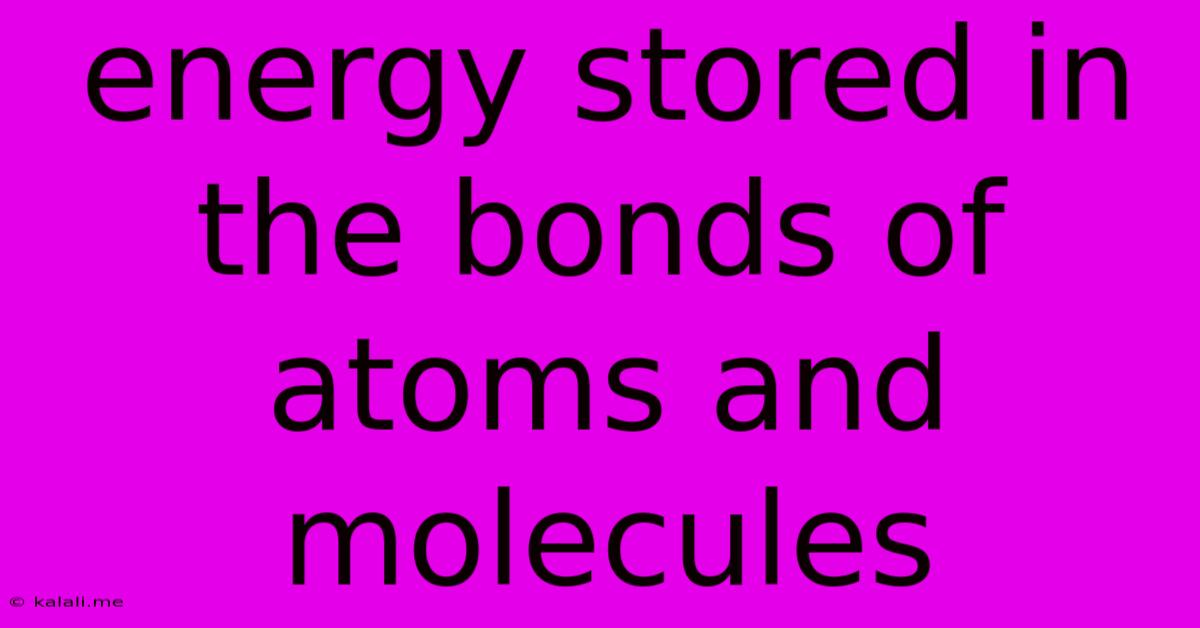Energy Stored In The Bonds Of Atoms And Molecules
Kalali
Jun 15, 2025 · 3 min read

Table of Contents
The Hidden Powerhouse: Energy Stored in Atomic and Molecular Bonds
Meta Description: Unlock the secrets of chemical energy! This article delves into the fascinating world of energy stored within the bonds of atoms and molecules, explaining bond types, energy changes, and real-world applications.
The world around us is powered by energy, much of which originates from the intricate dance of atoms and molecules. While we often think of energy sources like sunlight or fossil fuels, a fundamental source of energy lies hidden within the very fabric of matter: the chemical bonds that hold atoms together. Understanding how energy is stored and released in these bonds is crucial to comprehending various natural processes and technological advancements.
What are Chemical Bonds and How Do They Store Energy?
Chemical bonds are the forces that hold atoms together in molecules and compounds. These bonds form because atoms are most stable when their outermost electron shells are filled. By sharing, gaining, or losing electrons, atoms achieve this stability, creating a bond. The process of bond formation releases energy, and this released energy is then stored within the bond itself, much like a compressed spring stores potential energy.
There are several types of chemical bonds, each with varying energy storage capabilities:
-
Covalent Bonds: These are formed by the sharing of electrons between two atoms. The strength of a covalent bond depends on the atoms involved and the number of shared electrons. Stronger covalent bonds store more energy. Examples include the bonds in water (H₂O) and methane (CH₄).
-
Ionic Bonds: These bonds form through the transfer of electrons from one atom to another, creating ions with opposite charges that attract each other. Ionic bonds are generally strong, resulting in significant energy storage. Sodium chloride (NaCl, table salt) is a classic example.
-
Metallic Bonds: Found in metals, these bonds involve a "sea" of delocalized electrons shared among many metal atoms. This creates a relatively strong bond, contributing to the characteristic properties of metals, like malleability and conductivity.
Energy Changes During Bond Formation and Breaking
The energy stored in chemical bonds is directly related to the bond's strength. Breaking a bond requires energy input – you need to supply energy to overcome the attractive forces holding the atoms together. Conversely, forming a bond releases energy. This energy exchange is crucial for understanding chemical reactions.
Exothermic Reactions: Reactions that release energy as they proceed, often because the bonds formed in the products are stronger than the bonds broken in the reactants. Combustion is a prime example – the bonds formed in carbon dioxide and water are stronger than the bonds in fuel and oxygen, releasing a significant amount of energy in the form of heat and light.
Endothermic Reactions: These reactions require energy input to occur, typically because the bonds formed in the products are weaker than the bonds broken in the reactants. Photosynthesis is a classic example; it requires energy from sunlight to convert carbon dioxide and water into glucose and oxygen.
Real-World Applications
The principle of energy stored in chemical bonds underpins numerous applications:
-
Fossil Fuels: The combustion of fossil fuels (coal, oil, and natural gas) releases energy stored in the carbon-hydrogen and carbon-carbon bonds of these molecules.
-
Batteries: Batteries store energy by facilitating reversible chemical reactions. The energy is stored in the chemical bonds of the reactants and released during discharge.
-
Food: The energy we obtain from food is derived from the breaking of chemical bonds in carbohydrates, fats, and proteins during digestion.
-
Biofuels: Biofuels utilize energy stored in the bonds of plant-based materials.
Understanding the energy stored within the bonds of atoms and molecules is not just a matter of academic curiosity. It is a fundamental concept that explains how our world functions, from the energy we consume to the biological processes that sustain life. Further research and innovation in this field will continue to drive advancements in energy production and storage, shaping our future.
Latest Posts
Latest Posts
-
Which Two Countries Share The Longest Border In The World
Jun 15, 2025
-
Which Is An Example Of An Input Device
Jun 15, 2025
-
What Is The First Half Of The Alphabet
Jun 15, 2025
-
The Demand Curve For A Perfectly Competitive Firm Is
Jun 15, 2025
-
Which Word Does Not Belong In The Following List
Jun 15, 2025
Related Post
Thank you for visiting our website which covers about Energy Stored In The Bonds Of Atoms And Molecules . We hope the information provided has been useful to you. Feel free to contact us if you have any questions or need further assistance. See you next time and don't miss to bookmark.